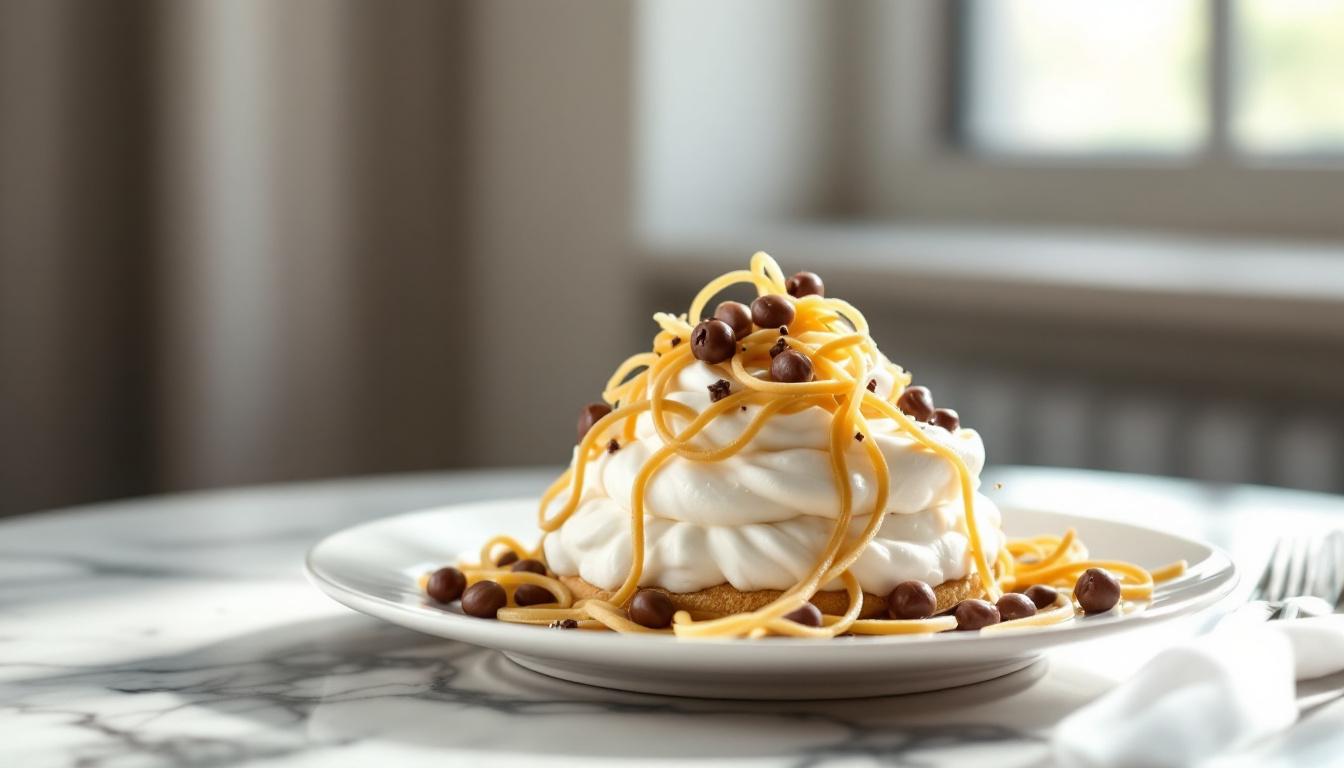The first time I encountered Mont-Blanc in its authentic French glory, I was working at a small patisserie in Lyon. I watched in awe as the head chef transformed humble chestnuts into elegant vermicelli that cascaded over pillowy clouds of chantilly cream. “This dessert,” he told me, “is architecture, sculpture, and flavor in perfect harmony.” What captivated me most wasn’t just the stunning visual resemblance to the snow-capped Alpine peak it’s named after, but how three simple components—meringue, cream, and chestnut—could create such a profound sensory experience. The secret? The delicate balance between the crisp meringue, the ethereal cream, and those distinctive chestnut strands that must be crafted with precision and patience.
The Story Behind Mont-Blanc 📖
Created in the 19th century and popularized by the famous Parisian tea salon Angelina, Mont-Blanc represents the pinnacle of French pastry minimalism. While researching historic recipes, I discovered that the earliest versions used simple potato ricers to create those signature chestnut strands—a technique that home cooks can still employ today. The dessert gained international fame not through elaborate innovation but through its perfect execution of texture contrasts: the crackle of meringue, the silky chantilly, and the unique mouthfeel of chestnut vermicelli coming together in each bite.
Ingredients Spotlight 🧪
For the meringue bases (6-8 servings):
– 3 large egg whites (90g), room temperature
– 150g granulated sugar
– Pinch of salt
– ½ tsp white vinegar
For the chantilly cream:
– 300ml heavy cream (minimum 35% fat)
– 30g powdered sugar
– 1 tsp vanilla extract or seeds from ½ vanilla pod
For the chestnut vermicelli:
– 250g unsweetened chestnut purée
– 100g sweetened chestnut cream (crème de marrons)
– 25g unsalted butter, softened
– 2 tbsp rum or 1 tsp vanilla extract
– Pinch of salt
Step-by-Step Guide 📝
1. Prepare the meringues: Preheat your oven to 225°F (110°C). In a spotlessly clean bowl, whip egg whites with salt until foamy. Gradually add sugar while continuously whipping until stiff, glossy peaks form. Add vinegar and mix briefly. Pipe or spoon 6-8 disc-shaped meringues (about 3 inches wide) onto a parchment-lined baking sheet. Bake for 1.5 hours, then turn off the oven and leave meringues inside to cool completely with the door ajar.
2. Make the chestnut mixture: In a medium bowl, combine chestnut purée, chestnut cream, softened butter, rum (or vanilla), and salt. Mix thoroughly until smooth and silky. The texture should be firm enough to hold shape but soft enough to pipe—like thick frosting. Refrigerate for at least 30 minutes.
3. Whip the chantilly cream: Using a chilled bowl and beaters, whip the cold heavy cream with powdered sugar and vanilla until soft peaks form. Be careful not to overwhip—the cream should be billowy and hold its shape without being stiff or grainy.
4. Assemble: Place each meringue disc on individual serving plates. Pipe or spoon a generous dome of chantilly cream onto each meringue. Fill a potato ricer, pastry bag with a small round tip, or specialized vermicelli tool with the chilled chestnut mixture. Press the mixture over the cream in a circular motion, creating thin strands that cascade down like a mountain peak. Dust lightly with powdered sugar if desired.
Expert Techniques 🛠️
The vermicelli technique makes or breaks this dessert. My breakthrough came when I learned to properly chill both the chestnut mixture AND the potato ricer before pressing. This prevents the strands from becoming sticky or breaking. If you don’t have a ricer, try a colander with small holes—press the mixture through using the back of a wooden spoon using steady, even pressure.
Chef’s Note: The butter in the chestnut mixture isn’t just for flavor—it’s structural. It provides the perfect viscosity for creating those delicate strands and prevents them from drying out. This is similar to how butter enriches the texture in classic French chocolate pudding.
The meringue should be crisp but not hard—baking at a low temperature is essential. Think of the meringue technique as similar to making financiers—precision with temperature yields the perfect texture.
Presentation & Pairing Ideas 🍽️
Mont-Blanc should be assembled just before serving to preserve the contrasting textures. For a contemporary twist, I sometimes serve mine with a small pour of chilled Sauternes or a spoonful of dark chocolate mousse alongside for dipping. The dessert’s chestnut notes pair beautifully with coffee, especially an espresso with a twist of orange peel.
For an impressive dinner party variation, try building a large-format Mont-Blanc: create one large meringue disc (like a pavlova), top with chantilly, and cascade the vermicelli over the entire creation. This communal version creates a showstopping centerpiece reminiscent of how the Tarte Tropézienne transforms from individual pastry to celebration cake.
Mont-Blanc isn’t just a dessert—it’s an exercise in pastry precision that rewards attention to detail. What makes this century-old creation so special is that it remains fundamentally unchanged, proving that when something is perfectly conceived, innovation takes a back seat to execution. Master these three components, and you’ll create a dessert that honors its Alpine namesake with every magnificent bite.
